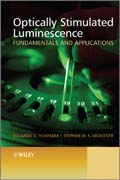
Optically stimulated luminescence: fundamentals and applications
McKeever, Stephen
Yukihara, Eduardo G.
INDICE: Preface. Acknowledgments. Disclaimer. List of Acronyms. 1 Introduction. 1.1 A Short History of Optically Stimulated Luminescence. 1.2 Brief Description of Successful Applications. 1.2.1 Personal. 1.2.2 Space. 1.2.3 Medical.1.2.4 Security. 1.3 The Future. 2 Theory and Practical Aspects. 2.1 Introduction. 2.2 Basic Aspects of the OSL Phenomenon. 2.2.1 Energy Levels in Perfect Crystals. 2.2.2 Defects in the Crystal. 2.2.3 Excitation of the Crystal by Ionizing Radiation. 2.2.4 Trapping and Recombination at Defect Levels. 2.2.5 Thermal Stimulation of Trapped Charges. 2.2.6 Optical Stimulation of Trapped Charges. 2.2.7 The Luminescence Process. 2.2.8 Rate Equations for OSL and TL Processes. 2.2.9 Temperature Dependence of the OSL Signal. 2.2.10 Other OSL Models. 2.3 OSL Readout. 2.3.1 Basic Elements of an OSL Reader. 2.3.2 Stimulation Modalities. 2.4 Instrumentation. 2.4.1 Light Sources. 2.4.2 Light Detectors. 2.4.3 Optical Filters. 2.4.4 Light Collection. 2.4.5 Sample Heaters. 2.5 Available OSL Readers. 2.5.1 Experimental Arrangements. 2.5.2 Automated Research Readers.2.5.3 Commercial Dosimetry Readers. 2.5.4 Optical Fiber Systems. 2.5.5 Imaging Systems. 2.5.6 Portable OSL Readers. 2.6 Complementary Techniques. 2.6.1 OSLEmission and Stimulation Spectrum. 2.6.2 Lifetime and Time-Resolved OSL Measurements. 2.6.3 Correlations Between OSL and TL. 2.6.4 Other Phenomena. 2.7 Overview of OSL Materials. 2.7.1 Artificial Materials. 2.7.2 Natural Materials. 2.7.3 Electronic Components. 2.7.4 Other OSL Materials and Material Needs. 3 Personal Dosimetry. 3.1 Introduction. 3.2 Quantities of Interest. 3.2.1 AbsorbedDose and Other Physical Quantities. 3.2.2 Protection Quantities. 3.2.3 Operational Quantities. 3.3 Dosimetry Considerations. 3.3.1 Definitions. 3.3.2 Dose Calculation Algorithm. 3.3.3 Reference Calibration Fields for Personal and Area Dosimeters. 3.3.4 Uncertainty Analysis and Expression of Uncertainty. 3.4 Detectors. 3.4.1 General Characteristics. 3.4.2 Al2O3:C Detectors. 3.4.3 BeO Detectors. 3.5 Dosimetry Systems. 3.5.1 Luxel+ Dosimetry System. 3.5.2 InLight Dosimetry System. 3.6 Neutron-Sensitive OSL Detectors. 3.6.1 Development of Neutron-Sensitive OSL Detectors. 3.6.2 Properties of OSLN Detectors. 3.6.3 Ionization Density Effects. 4 Space Dosimetry. 4.1 Introduction. 4.2 Space Radiation Environment. 4.2.1 Galactic Cosmic Rays (GCR). 4.2.2 Earths Radiation Belts (ERB). 4.2.3 Solar Particle Events (SPEs). 4.2.4 Secondary Radiation. 4.3 Quantities of Interest. 4.3.1 Absorbed Dose, D. 4.3.2 Dose Equivalent, H. 4.3.3 Equivalent Dose, HT. 4.3.4 Effective Dose, E. 4.3.5 Gray-Equivalent, GT. 4.4 Health Risk. 4.5 Evaluation of Dose in Space Radiation Fields Using OSLDs (and TLDs). 4.5.1 The Calibration Problem for Space Radiation Fields. 4.5.2 Thermoluminescence, TL. 4.5.3 Opt
- ISBN: 978-0-470-69725-2
- Editorial: John Wiley & Sons
- Encuadernacion: Cartoné
- Páginas: 384
- Fecha Publicación: 04/02/2011
- Nº Volúmenes: 1
- Idioma: Inglés
